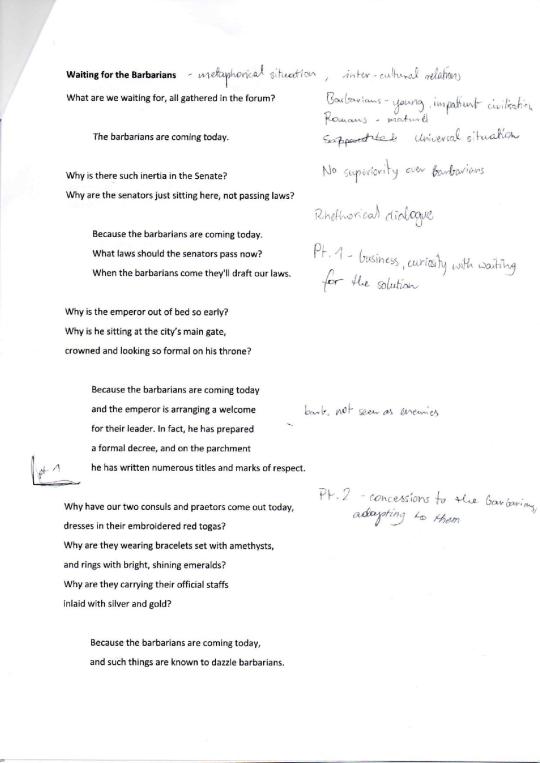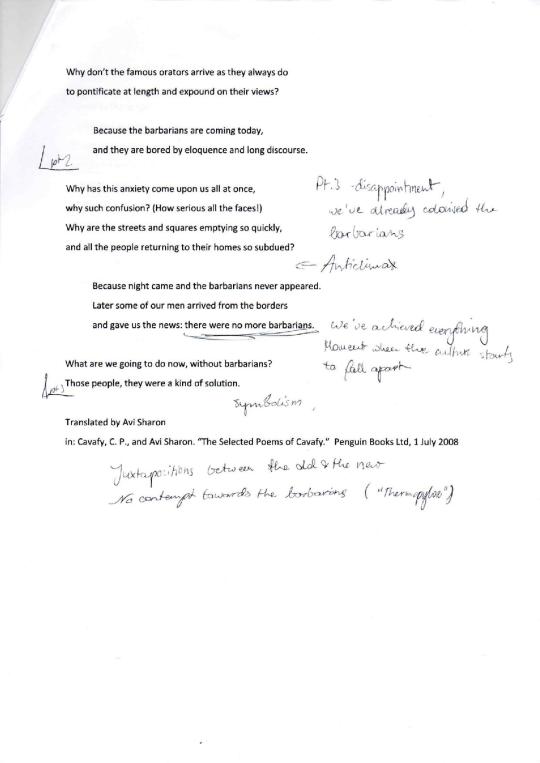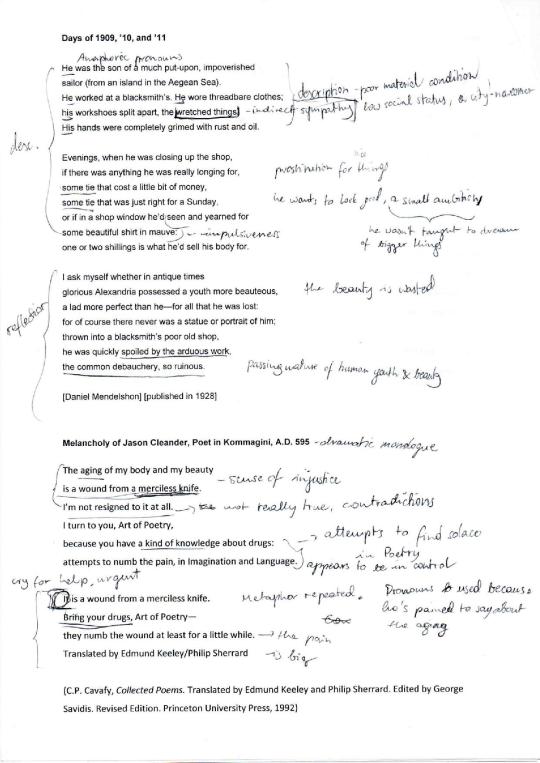Don't wanna be here? Send us removal request.
Text
Ghadirian Task

In her Qajar Series, Shadi Ghadirian explores the modern feminine Iranian identity. She shows the contrasts which exist in the country, the persisting impact of the past traditions on current life. It is visible in the form and colour palette the photos use - the subject matter of the photos are traditionally dressed women, referencing the first photo collections of a Persian king who avidly photographed his harem. The colours are reminiscent of 19th century sepia. What is more, the artist does not only delve into the Persian/Iranian photographic tradition, but also, by the use of the painted backdrop, plays with the orientalist, romantic perception of Persia typical of 19th century Europeans.
Additionally, in this photo, that background is contrasted with the floor tiles, adding to the unnaturality of the picture. The latter is created primarily by contrasting the mens’ bike and helmet and the traditional dress of the woman using it. Such is the first way in which the subject ( / outlook on the global issue) - the limits placed on women in traditional religious societies - is conveyed. Iranian women, as any other, do not wish to their freedom to be constricted. Furthermore, these women are not scared - they provoke. The woman closer to the camera is staring directly at the lens (or the viewer), and leaning towards it, taking a confrontative stance.
3 notes
·
View notes
Text
Bullying as a consequence of different social backgrounds in “Wide Sargasso Sea”

In WSS, the social dynamics are somewhat unusual, and so is bullying in this extract - it is the member of the theoretically more privileged class, Antoinette, who gets bullied. Hostility towards the member of the white minority is thus expressed by the black kids, though it is motivated more by a wish for vendetta than any ideological or economic stance (as happened with the discrimination against the black population.) It is important to note, though, that the black children bully Antoinette not on the basis of her race, but on the social position of her mother, of which race was but one component. Bullying is unfortunately still present in today’s schools, and it may be so that way because one’s social position always influences (to differening extents) one’s perception by others; and it is easier to obtain acquiescence for bullying if the bullied is perceived as being alien to the community.
1 note
·
View note
Text
A Dry White Season, André Brink
After a while Ben asked: “Why did Emily send you? Is there something she’d like me to do?”
“Nothing much.” Stanley crossed his massive legs. One trouser leg was pulled up, revealing a red sock above the white shoe. “I had to come this way for a fare, so she asked me to drop in. Just to tell you not to worry.”
“My God, why should she be thinking about me?”
“Search me.” He grinned and blew out a series of smoke circles.
“Stanley, how did you meet Gordon and his family? For how long have you been friends? How come you’re always there when they need help?”
A laugh. “I got a car, man. Don’t you know?”
“What difference does a car make?”
“All the diff in the world, lanie.” That name again, like a small fierce ball of clay from a clay‑stick hitting one right between the eyes. Stanley changed into a more comfortable position. “If you got a taxi like me, you’re right there, man. All the time. I mean, here you get a bloke pasa’d by the tsotsis, so you pick him up and take him home, or you take him to Baragwanath Hospital. There you get one passed out from atshitshi: same thing. Or a chap who drank too much divorce in a beer-hall. Others looking for phata-phata” – illustrated by pushing his thumb through two fingers in the immemorial sign – “so you find them a skarapafet. A whore. See what I mean? You’re on the spot, man. You pick them up, you listen to their sob stories, you’re their bank when they need some magageba”- rubbing his fingers together-“all the time, I tell you. You got a taxi, you’re the first to know when the gattes are coming on a raid, so you can warn your pals. You know every blackjack, you know his price. You know where to find a place to sleep or a place to hide. You know the shebeens. Man needs a stinka, he comes straight to you.”
“A stinka?”
Gleeful, perhaps not without disdain, Stanley stared at him, then laughed again. “A reference book, man. A domboek. A pass.”
#YouHaveRightsNYC campaign ad, NYC Commission on Human Rights

1. Global issue: unequal access to goods and services as a result of racial discrimination; provenance of the fragments, origins of the works (1979, 2016) 2. Fragment 1: depth of the issue shown by what Stanley can do with a car (enumeration, anaphora 1923); multitude of African words => impact of the GI on communities 3. Perception (and/or lack of thereof) of black problems shown by Ben’s questions; lanie making Ben realise that distance between races (happens often when with Stanley) 4. Novel: Tightness of bonds in the black community shown by counteracting all the problems caused by the GI together – ways of overcoming (/coping with) the problem 5. Plot built on unfairness of the three state powers (esp. judiciary and police); propagandainduced oblivion towards racial issues among the Boer population 6. Fragment 2: salience of the face, negative space => focus on the person; use of colour on the most important elements of the copy => GI as something to be resolved 7. Testimony-likeness of the quote, presents GI as something affecting very basic aspects of life of the everyman; firm tone; affirmation (I should – You do) 8. Body of work: Governmentmandated aid (contact information); discrimination not coming from the ruling authority 9. Variety of characters in the campaign, flyers available in different languages – range of GI, target audience; same scheme with different colours - cohesive message 10. Conclusion: two different perspectives on the GI, different text types: ad – limited presentation of GI; novel – more thorough one; though both show how impactful it is
1 note
·
View note
Text
Intra- and interracial divisions created by an opressive regime

This scene illustrates not only how an opressive regime - apartheid in this case - is able to create interracial divisions -- or, to be more precise, create divsions between the oppressed and the oppressor, such as exists between Robert and Ben (though it would be more accurate to describe Ben as belonging to the oppressing class, for he himself acts against the system) -- but also how it is able to install an intra-class division, as can be seen by the difference in attitudes towards Ben expressed by Robert and the black priest. We know from history that divisions such as these between South African tribes (notably the Xhosa and the Zulu), who had all been oppressed under apartheid, resulted in violence when the regime fell. This problem repeats itself time and again through history wherever there is a regime to which multiple groups are opposed (e.g. WW2 in China - both the Kuomintang and the communists fought together against the Japanese, returning to the civil war soon after the invaders were driven out). Though the scale/intensity of the conflict within the opposition need not be so strong as in 20th cent. China (see the divisions in the Polish political opposition to PiS), this problem seems to be inevitable, as long as there are two different opposing groups with divergent views on how the future should look like.
1 note
·
View note
Text
Decadence of consumerist society as shown by “My Dress Hangs There”

The picture depicts symbols of American culture in a sardonic manner. By putting irrelevant objects, such as a toilet or a sports trophy on pedestals above the poor and hungry masses of people, Frida Kahlo depicts the hypocrisy of consumerism present in the US (I think it is even more pronounced today). Kahlo, coming from an entirely different culture, despite the geographical proximity of the two countries, is unable to adapt to the dollar-worship - only her dress is present, not her own self. I find it interesting how the picture stayed relevant over the time of almost 90 years - almost all elements, maybe besides the toilet, are still somehow relevant. The poor masses of people, the obsession with competitive sports, money, the celebrity culture.
2 notes
·
View notes
Text
Mock IO fragments
Global issue: Totalitarian governments’ use of propaganda to facilitate exerting control over the population
The Handmaid’s Tale by Margaret Atwood
They only show us victories, never defeats. Who wants bad news?
Possibly he's an actor.
The anchorman comes on now. His manner is kindly, fatherly; he gazes out at us from the screen, looking, with his tan and his white hair and candid eyes, wise wrinkles around them, like everybody's ideal grandfather. What he's telling us, his level smile implies, is for our own good. Everything will be all right soon. I promise. There will be peace. You must trust. You must go to sleep, like good children.
He tells us what we long to believe. He's very convincing. I struggle against him. He's like an old movie star, I tell myself, with false teeth and a face job. At the same time I sway towards him, like one hypnotized. If only it were true. If only I could believe.
Now he's telling us that an underground espionage ring has been cracked by a team of Eyes, working with an inside informant. The ring has been smuggling precious national resources over the border into Canada.
"Five members of the heretical sect of Quakers have been arrested," he says, smiling blandly, "and more arrests are anticipated."
Two of the Quakers appear onscreen, a man and a woman. They look terrified, but they're trying to preserve some dignity in front of the camera. The man has a large dark mark on his forehead; the woman's veil has been torn off, and her hair falls in strands over her face. Both of them are about fifty.
Now we can see a city, again from the air. This used to be Detroit. Under the voice of the announcer there’s the thunk of artillery. From the skyline columns of smoke ascend.
“Resettlement of the Children of Ham is continuing on schedule,” says the reassuring pink face, back on screen. “Three thousand have arrived this week in National Homeland One, with another two thousand in transit.” How are they transporting that many people at once? Trains, buses? We are not shown any pictures of this. National Homeland One is in North Dakota. Lord knows what they’re supposed to do, once they get there. Farm, is the theory.
China Tries to Counter Xinjiang Backlash with … a Musical? Amy Qin for the New York Times
In the government’s telling, Xinjiang is now a peaceful place where Han Chinese, the nation’s dominant ethnic group, live in harmony alongside the region’s Muslim ethnic minorities, just like the “seeds of a pomegranate.” It’s a place where the government has successfully emancipated women from the shackles of extremist thinking. And the region’s ethnic minorities are portrayed as grateful for the government’s efforts.
The musical takes the narrative to a new cringe-inducing level. It tells the story of three young men, a Uyghur, a Kazakh and a Han Chinese, who come together to pursue their musical dreams.
The movie depicts Xinjiang, a predominantly Muslim region in China’s far west, as scrubbed free of Islamic influence. Young Uyghur men are clean-shaven and seen chugging beers, free of the beards and abstinence from alcohol that the authorities see as signs of religious extremism. Uyghur women are seen without traditional head scarves.
The Uyghurs and other Central Asian ethnic minorities, seen through this lens, are also portrayed as fully assimilated into the mainstream. They are fluent in Chinese, with few, if any, hints of their native languages. They get along well with the Han Chinese ethnic majority, with no sense of the long-simmering resentment among Uyghurs and other minorities over systematic discrimination.
The narrative presents a picture starkly different from the reality on the ground, in which the authorities maintain tight control using a dense network of surveillance cameras and police posts, and have detained many Uyghurs and other Muslims in mass internment camps and prisons. As of Monday, the film had brought in a dismal $109,000 at the box office, according to Maoyan, a company that tracks ticket sales.
Chinese officials initially denied the existence of the region’s internment camps. Then they described the facilities as “boarding schools” in which attendance was completely voluntary.
Now, the government is increasingly adopting a more combative approach, seeking to justify its policies as necessary to combat terrorism and separatism in the region.
3 notes
·
View notes
Text
“The Handmaid’s Tale,” “The Bookseller of Kabul,” advertising notes
As I’ve worked on and annotated pdfs, and can’t really think of a better way of sharing, I will just paste the link to an appropriate Google Drive folder. https://drive.google.com/drive/folders/1qbE9jqGfoJu-qu_Pse6X9vGWhMqbcBqA?usp=sharing
2 notes
·
View notes
Text
TOK reflection
How did the addition of proper context influence my perception of Atwood’s “The Handmaid’s Tale”?
1. Before the intro lessons I hadn’t been aware of the extent to which the rise of the New Right in the 1980s in the US influenced the social and cultural rights, and especially the issue of the rights of women (learning about the situation where many women’s rights’ gains could have been turned back in the 80s’ America was shocking – though the more I learn about the US, the less shocking such facts become.) This better explains the author’s motivations for writing the novel. Similarly, I wasn’t aware that Atwood also looked at the lives of women behind the Iron Curtain as the very opposites of the lives of women in the New Right’s ideal world.
2. Another point is that all the basic ideas of the novel’s world are not anything new – they base on Puritan lifestyle and values mixed with the methods of control of a modern authoritarian state. This is quite disturbing. The fact that, in essence, Atwood was just rewriting and mixing historical (and contemporary – Iran) concepts, had not really been apparent to me until it was pointed out, though it seems to be rather obvious now.
3. The fact that HT is a satire – designed to point out society’s flaws – was also new. What is more, it is a satire by extrapolation – taking the negative issues to the maximum. I also learned that satires need not be entirely humorous, though there is some dark humour in the novel itself. Seeing the novel as a warning or a critique of the society gives it another dimension, where it is not just some detached dystopia (from what I understood dystopias are generally assumed not to come true in the real world(?))
4. The environmentalist views of Atwood made it very clear as to why ecological catastrophe lies at the very heart of the existence of Gilead.
5. Another interesting reading provided by the introductory lessons was that HT is, in a way, an image of Canadian‑American relations. I was also surprised about Atwood’s activism for Canadian independence from the US (because, to me at least, it is obvious that a country’s culture, economy, and politics will be shaped by what happens in the world’s economically – and for quite some time politically – strongest nation, especially if it lies just across the southern border; and especially if they are both ex-colonies of the same empire – though Canada has a unique asset of Québec, at least.)
3 notes
·
View notes
Photo



Here are the scans of the poems I found the most interesting
2 notes
·
View notes

















